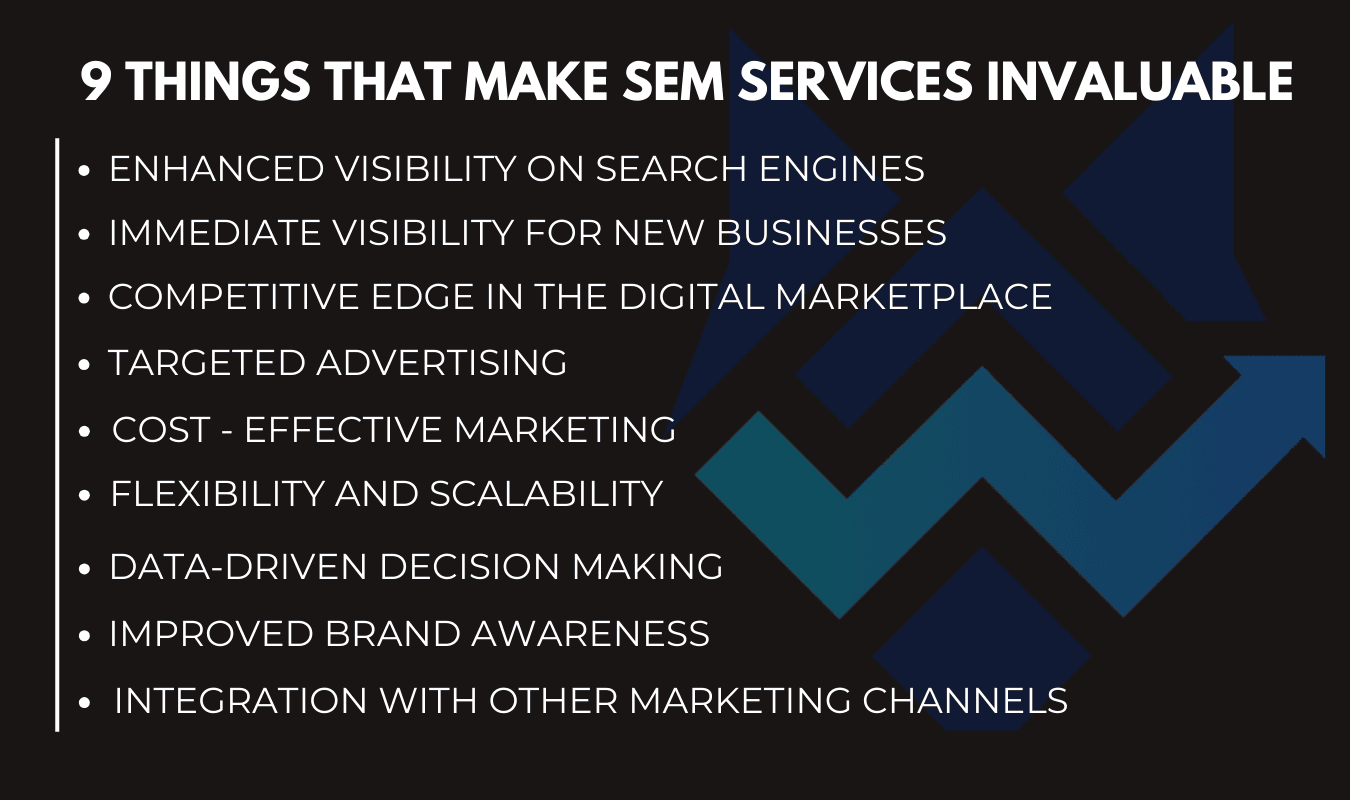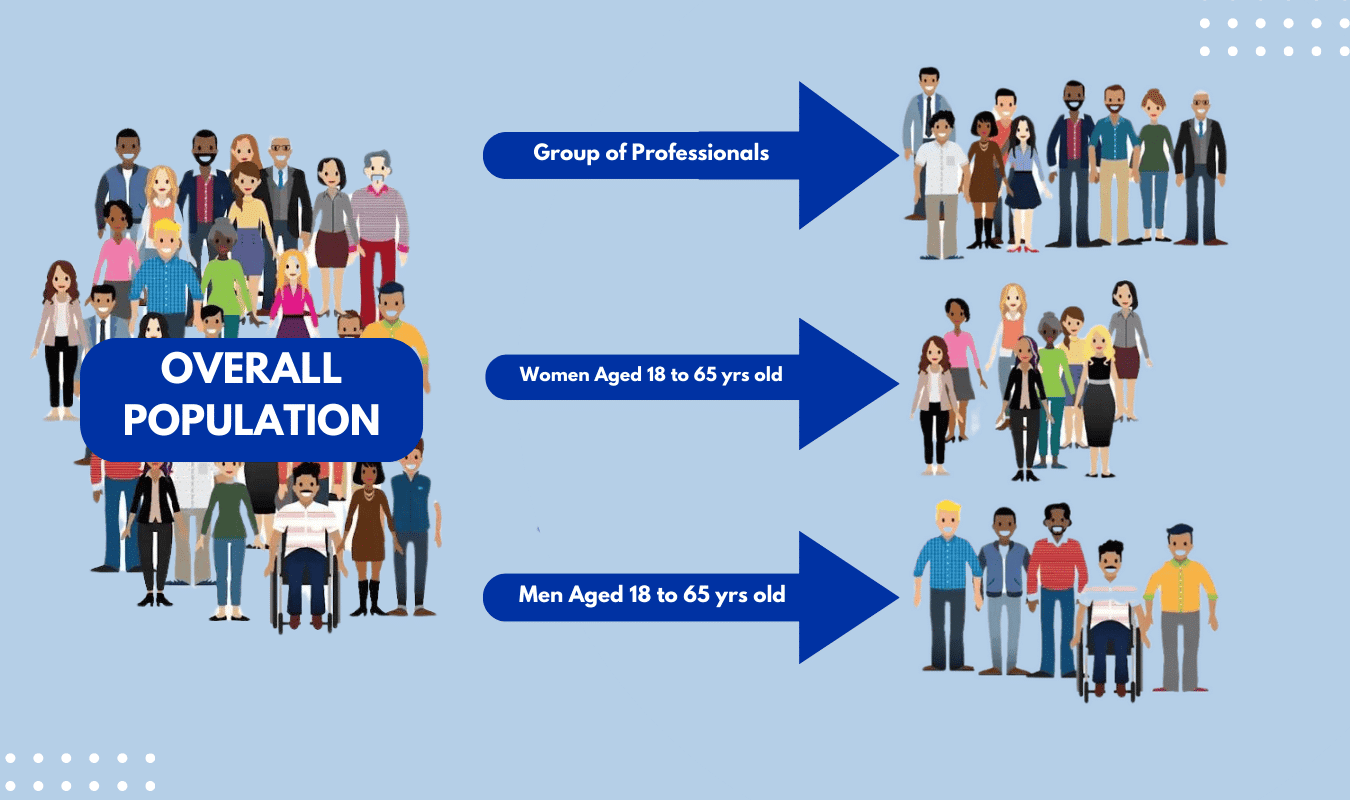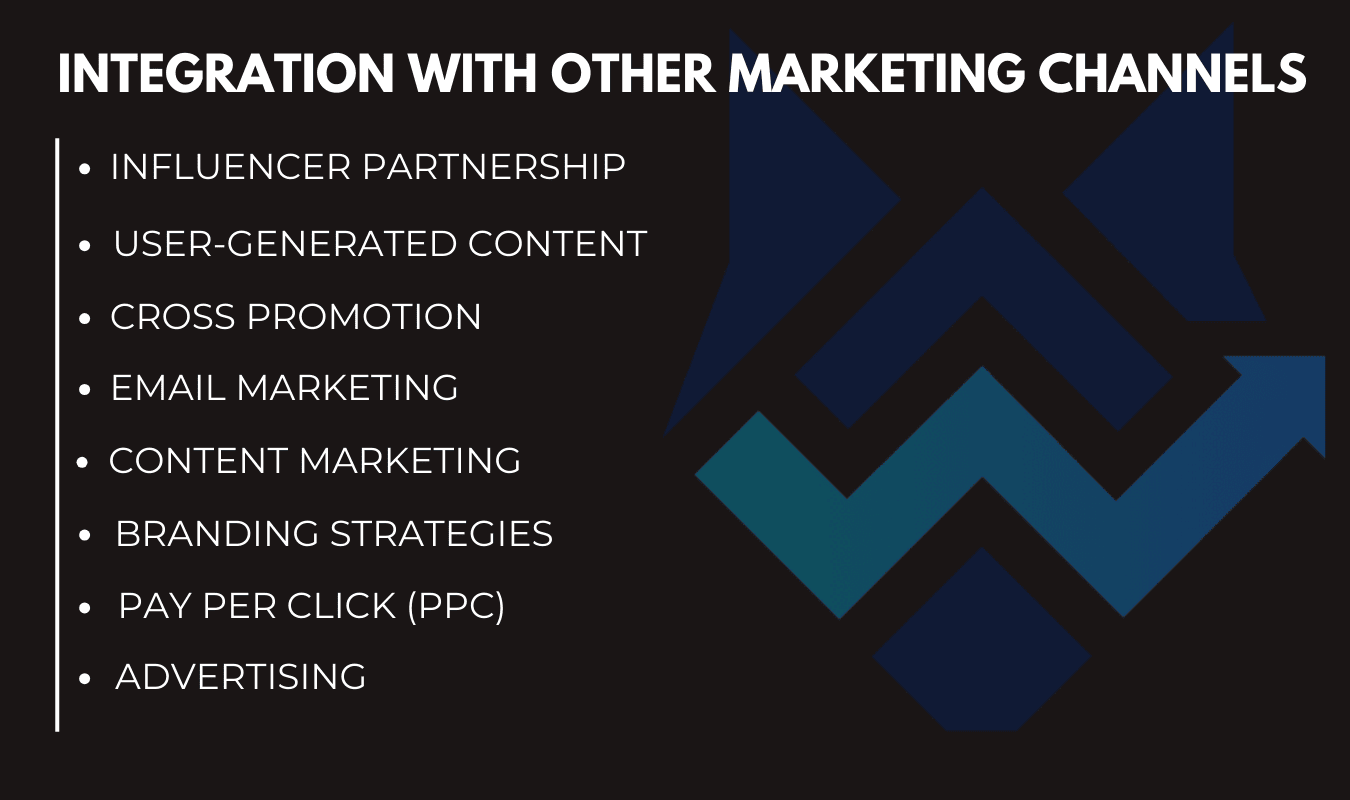Search Engine Marketing (SEM) services have become an essential part of digital marketing strategies for businesses of all sizes. But what exactly are SEM services, and why are they so invaluable? In this blog post, we’ll explore nine key benefits that make SEM services a crucial investment for any business looking to thrive online.
We will also highlight a few valuable CRM skills and how they can enhance your SEM efforts by nurturing leads to create satisfied, returning customers while attracting new business. We’ll start by explaining the importance of SEM services, and then provide practical ways to start exceeding expectations today.

Enhanced Visibility on Search Engines
SEM services significantly enhance your visibility on search engines. According to studies, the competitive online landscape necessitates effective SEM strategies to stand out and drive traffic to your site. Businesses that use Google Ads see an average return of $2 for every $1 spent, showcasing SEM’s efficiency in boosting visibility and driving growth.
Immediate Visibility for New Businesses
Unlike Search Engine Optimization (SEO), which can take months to show results, SEM offers immediate visibility. This is particularly beneficial for new businesses that need to make an impact quickly. For example, a new e-commerce store can use SEM to appear at the top of search results as soon as the campaign is launched, attracting customers immediately.
Competitive Edge in the Digital Marketplace
In the competitive digital marketplace, appearing at the top of search engine results pages (SERPs) is crucial. SEM services help businesses gain this competitive edge by placing their ads in prime positions. According to a recent study, 75% of users never scroll past the first page of search results, making top positions vital for visibility.
Targeted Advertising
SEM services offer unparalleled precision when it comes to targeting potential customers.
Precision Targeting Based on Demographics

- Targeted advertising stands as a cornerstone strategy that leverages demographic data to pinpoint specific segments of the market. By focusing on characteristics such as age, gender, income level, education, and ethnicity, advertisers can craft messages that resonate deeply with their intended audience. This precision targeting ensures that marketing efforts are not wasted on uninterested parties, but rather directed towards individuals who are most likely to respond positively to the products or services being offered.
- Demographic targeting is not just about reaching an audience, but about understanding the cultural, social, and economic factors that influence consumer behavior. By tailoring content to meet the unique needs and desires of different demographic groups, businesses can establish a stronger connection with potential customers, ultimately leading to increased brand loyalty and higher conversion rates.
Behavioral Targeting for Better Conversion Rates
Beyond demographics, behavioral targeting represents a dynamic and sophisticated technique that taps into the power of data analytics to observe and interpret user behavior. This method involves tracking online activities such as search queries, website visits, content engagement, and purchase history to form a comprehensive profile of individual consumers.
Armed with this in-depth knowledge, advertisers can deliver hyper-personalized advertisements that align with the user’s past behavior, anticipating needs and interests before they are explicitly expressed. The result is a more intuitive and seamless shopping experience for the consumer, which significantly boosts the likelihood of conversion.
Behavioral targeting also allows for continuous optimization of advertising campaigns. By constantly analyzing the performance of ads and the actions taken by users after exposure to these ads, marketers can refine their strategies in real-time, ensuring maximum impact and efficiency.
Cost-Effective Marketing
Businesses are constantly seeking ways to achieve their marketing objectives without overspending. Cost-effective marketing is about finding strategies that provide the best possible outcomes for the least amount of investment. This involves leveraging both traditional and digital channels, such as social media, content marketing, email campaigns, and SEO optimization, which can offer substantial reach without the hefty price tag of traditional advertising.
Budget Control and Optimization
Effective budget control and optimization are critical components of any successful marketing plan. Companies must establish a clear budget that aligns with their marketing goals and business priorities. By using tools like cost-per-click (CPC) models, businesses can maintain tight control over their spending, ensuring they only pay when potential customers engage with their ads. Additionally, utilizing analytics platforms helps in monitoring campaign performance in real time, allowing for swift adjustments to optimize spending and resource allocation.
Measurable ROI
The ultimate goal of any marketing initiative is to generate a positive return on investment. Measurable ROI is not just about tracking sales; it’s about understanding which marketing activities lead to customer engagement, conversion, and retention. Key performance indicators (KPIs), such as customer acquisition cost (CAC), customer lifetime value (CLV), and conversion rates, are vital metrics that help quantify the effectiveness of marketing efforts. By analyzing these metrics, marketers can refine their strategies to improve ROI, making informed decisions based on data-driven insights.
To ensure that marketing efforts are both cost-effective and profitable, businesses must focus on strategies that are not only affordable but also targeted and measurable. The integration of technology and analytics into marketing practices has made it easier than ever to track performance and adjust tactics for maximum impact, ensuring that every marketing dollar is well spent.
Flexibility and Scalability
Flexibility in advertising is crucial for any business. The ability to quickly modify ad campaigns in response to market conditions, customer behavior, or budget changes can separate successful campaigns from those that do not perform well.
Ad Campaign Adjustments
Adjusting your ad campaigns should be a straightforward process. This includes:
- A/B Testing: Regularly test different versions of your ads to determine which variations perform best. For example, you can experiment with different headlines, images, or call-to-action buttons to optimize your ad effectiveness.
- Budget Management: Adjust your ad spending based on the performance and ROI of your campaigns. This involves experimenting with different budgets and bidding strategies to find the most effective allocation of your resources.
- Target Audience Refinement: Continuously refine your target audience by analyzing campaign analytics and market trends. Use data-driven insights to adjust your targeting parameters, ensuring your ads reach the most relevant and engaged audience.

Scaling Campaigns According to Business Growth
As your business grows, your ad campaigns should scale seamlessly alongside it. Here’s how to ensure scalability:
- Automated Bidding Strategies: Implement automated bidding strategies that adjust to conversion goals and budget constraints.
- Cross-Channel Expansion: Expand successful campaigns across different channels to increase reach.
- Data-Driven Decisions: Always rely on data to inform scaling decisions.
Data-Driven Decision Making
In the contemporary business landscape, Data-Driven Decision Making (DDDM) is not just a buzzword but a fundamental approach to achieving competitive advantage. Organizations that harness the power of data can make more objective and accurate decisions. DDDM involves collecting data, extracting patterns and insights, and applying these findings to guide strategic business moves and operational functions.
The Importance of Analytics and Reporting
Analytics and reporting are the pillars supporting effective DDDM. By leveraging advanced analytics techniques, businesses can transform raw data into actionable intelligence.
Key benefits include:
- Enhanced Operational Efficiency: Through detailed reports, companies can streamline operations, reduce costs, and optimize processes.
- Improved Customer Experience: Analytics help in understanding customer preferences and behaviors, leading to better service and product offerings.
- Risk Management: Predictive analytics enable organizations to anticipate potential risks and mitigate them before they escalate.
Effective reporting communicates complex data points in a clear and understandable manner, allowing stakeholders to grasp the implications quickly and act accordingly.
Insight-Driven Strategy Development
Developing an Insight-Driven Strategy requires a shift from traditional decision-making practices to one where every strategic move is backed by empirical data. This transition involves:
- Cultivating a Data Culture: Encouraging an organizational culture that values data literacy and promotes the sharing of insights across departments.
- Investing in Technology: Implementing robust data management and analytics tools that can handle large volumes of data with speed and accuracy.
- Continuous Learning and Adaptation: Staying agile and open to learning from the data to refine strategies continually.
By embedding data at the core of strategy development, organizations can ensure that their goals align with the realities of their market and customer needs, leading to sustained growth and success.
Improved Brand Awareness
Elevating your brand’s visibility and recognition is crucial in today’s competitive market. By leveraging targeted marketing campaigns, engaging content, and strategic partnerships, you can significantly increase the reach and impact of your brand message, ensuring that potential customers think of you first when considering their options.
Consistent Online Presence
Establishing a robust online presence is essential for brand longevity and customer engagement. Regular updates, responsive communication, and a unified voice across all digital platforms, including social media, blogs, and your official website, help build a community around your brand and foster loyalty among your audience.
Positive Brand Image through Ad Placements
Carefully curated ad placements are a powerful tool for shaping the public perception of your brand. By selecting appropriate and respected mediums for your advertisements, you communicate your brand’s values and commitment to quality. This strategic placement not only enhances visibility but also aligns your brand with positive user experiences and reputable content, thereby reinforcing trust and credibility with your target demographic.
Integration with Other Marketing Channels
Integrating various marketing channels is not just beneficial; it’s essential for a brand’s success. A well-orchestrated integration strategy can lead to a seamless customer experience, consistent messaging, and ultimately, a higher return on investment.

Synergy with SEO
Search Engine Optimization (SEO) is the backbone of digital visibility. When effectively integrated with other marketing efforts, it creates a powerful synergy that significantly enhances your online presence. The combined impact of SEO with web design, web hosting, and pay-per-click (PPC) advertising is undeniably transformative.
- Content Marketing: By aligning blog posts, whitepapers, and other content with keyword research, you improve the chances of ranking higher in search engine results pages (SERPs). For example, a blog post optimized for specific keywords can attract organic traffic, which can then be retargeted through other marketing channels.
- Pay Per Click (PPC): While SEO focuses on organic traffic, PPC targets paid traffic. Integrating both ensures that you dominate both paid and organic search results. For instance, analyzing the performance of PPC ad copy can provide insights into which keywords perform best and can be incorporated into your SEO strategy.
- Email Marketing: Email campaigns can benefit from SEO by including content that recipients are actively searching for. This increases the likelihood of email content being shared, thus expanding its reach. For example, an email newsletter featuring a well-performing blog post can drive additional traffic to your site.
Complementing Social Media Marketing
Social media platforms offer a unique opportunity to interact directly with customers and prospects. When used alongside other channels, they can amplify your marketing messages and foster community engagement.
- Influencer Partnerships: Collaborating with influencers can extend the reach of your campaigns beyond your existing audience. For example, an influencer talking about your product on Instagram can direct followers to a landing page where they can learn more or make a purchase.
- User-generated Content: Encouraging customers to share their experiences with your brand can lead to authentic content that resonates with potential buyers. For instance, a hashtag campaign on Twitter inviting users to post pictures of your product can generate buzz and provide social proof.
- Cross-Promotion: Utilizing multiple social platforms to promote content can increase visibility and engagement. For example, a live event streamed on Facebook can be promoted through tweets, encouraging a broader audience to participate.
Conclusion
In conclusion, SEM services are invaluable for businesses aiming to enhance their online presence, target specific audiences, and achieve measurable results. The benefits of SEM, such as enhanced visibility, immediate impact, competitive advantage, and cost-effective marketing, make it a crucial component of any digital marketing strategy.
Are you ready to take your business to the next level with SEM services? Reach out to Wolfpack Advising today to learn how we can help you develop a tailored SEM strategy that drives traffic, generates leads, and boosts your ROI.




